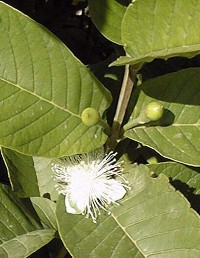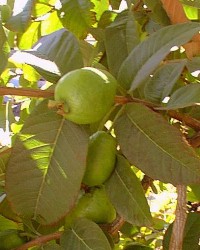Sunset®: 23,27
USDA: 9b-11
Frost Tolerance: Needs some frost protection in Phoenix on the coldest winter nights, foliage damaged at 28° F (-2° C), serious damage or death at 26° F (-3° C)
Heat Tolerance: Good heat resistance in Phoenix, it should still be kept in light shade
Sun Exposure: Full sun to light shade
Origin: Probably southern Mexico, Central America
Growth Habits: Semideciduous tree
Watering Needs: Infrequent water once established
Propagation: Seeds, cuttings, grafting, air layering

This American fruit is well known throughout the tropics, and in some countries it has become naturalized on wastelands. Usually, it is a low growing tree 6 to 25 feet high (1.8 to 7.5 m), but some varieties may reach 40 feet (12 m) under favorable conditions.
The smooth, reddish brown bark peels off in large flakes to reveal a smooth grey inner bark. In dry regions the 3- to 6 inches (7.5 to 15 cm) oblong leaves are shed for a brief period each year.
It is a good tropical fruit tree in Phoenix, It is not fussy on the soil quality, and produces fruit year after year. If you have only one subtropical fruit, that should be it.
Blooming Habits:
The fragrant greenish white to white flower, 1 inch (2.5 cm) or more across, bears numerous yellow stamens. The calyx lobes usually persist until the fruit ripens.
Fruiting Habits:
In shape, size and other characteristics, the fruits of the numerous varieties are extremely variable. They may be globular, ovoid, or pear shaped and from 1 to 6 inches in length (3 to 15 cm). In color, the skin may be greenish white, yellowish, or pink. In flavor, varieties range from sweet to tart, all with the characteristic musky flavor and odor of the guava more or less pronounced. Guava fruits also vary in the thickness of the fleshy mesocarp, which in some varieties is extremely thin. Most varieties bear many seeds embedded in the soft pulp of the center.
Upon ripening, the guava becomes soft and juicy. It may be eaten fresh, made into a juice or nectar contain fruit pulp, or made into preserves, jam, jelly, or paste. The guava is an excellent source of C vitamin.
Propagation:
The guava may be propagated by grafting or air layering but is commonly grown from seed. The disadvantage of the latter method is that seedlings do not always reproduce the characteristics of the parent. Seedlings bear fruit during the second year.
Desert-Tropicals is dedicated to provide gardening advice, gardening ideas, and information about flower of all kind for landscape and collections.We try to check carefully the identification of the plants on the illustrations as well as the other information from the page, but occasionally errors do occur. if you notice anything that needs to be changed please contact us.Thanks.
© 1998-2020 Philippe Faucon, All Rights Reserved.
